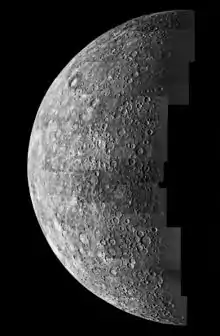Mercury-P
Mercury-P (Russian: Меркурий-П) is a mission concept for an orbiter and lander by the Russian Federal Space Agency to study the planet Mercury.[1] The initial study suggested a launch in 2024, [1] but because of crash of the Phobos-Grunt spacecraft, the implementation period was postponed to the 2030s.[1] The letter P in Mercury-P, stands for the Russian word 'posadka', meaning landing.[1]
 Artist's rendering of the Mercury-P spacecraft | |
| Mission type | Planetary reconnaissance |
|---|---|
| Operator | Russian Federal Space Agency |
| Spacecraft properties | |
| BOL mass | 8,120 kg[1] |
| Landing mass | 710 kg [2] |
| Payload mass | Lander: 40 kg [2] Orbiter: 50 kg[1] |
| Start of mission | |
| Launch date | Circa 2024 [3][4] |
| Rocket | Soyuz-2[1] |
| Mercury orbiter | |
| Mercury lander | |
Mercury-P would be the first soft lander on Mercury. A proposed flight scenario for the mission included a flyby of Venus, the insertion of the spacecraft into the orbit around Mercury and the delivery of a lander on its surface. The Institute of Space Research studied the possibility of "recycling" hardware developed for the Phobos-Grunt, Mars-NET, Mars-96, and Solar Sail spacecraft, with proposed upgrades of the hardware.[1] As of 2012, Russian scientists have conducted a preliminary concept study of the project, and compiled a list of the required scientific payload.[1][3]
References
- "Mercury-P project". Russianspaceweb. 13 January 2013.
- LAVOCHKIN ASSOCIATION - Space Missions. (PDF). Roscosmos 2010.
- Russian space probe aims to be the first to land on Venus' surface. October 17, 2012. Andrei Kislyakov Russia Beyond
- Roscosmos looking to win the Venus race. Andrei Kislyakov, Russia Beyond.October 18, 2012.


